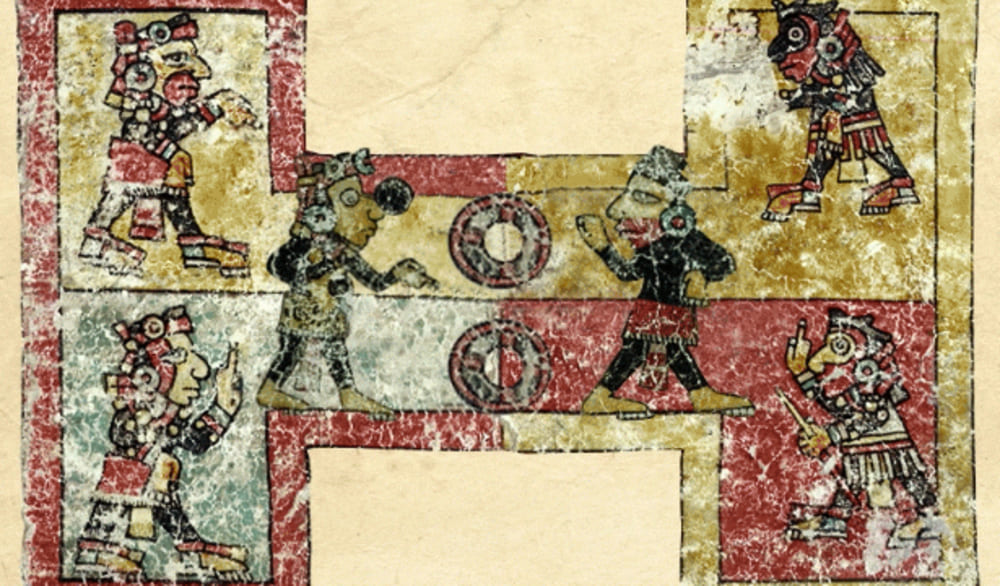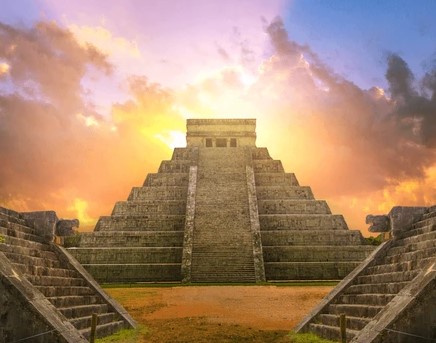
Aztec temples were typically part of a stepped pyramid and usually faced west. A stairway led to the sanctuary, where at the top was a sacrificial altar.
This altar was used to perform ritual sacrifices, including human sacrifices, in honor of the many gods revered by the Aztecs.
Members of the Aztec priesthood killed the victim (sometimes children) on the altar. Then they threw the corpse down the steps and presented the victim’s heart in the shrine of the god.
Aztec builders erected their temples with bricks, which they covered with stone and plaster.
Historical chronicles describe them as white structures adorned with bright colours.
Archaeological excavations at some of these temples have corroborated these descriptions. Although most Aztec temples were dedicated to a single deity, some were consecrated to two different gods.
Teotihuacán, Cholula and Tenochtitlán stand out as some main centers of Aztec worship.
Teotihuacan
The temples of Teotihuacan served as inspiration for the Aztecs. When the Aztecs came to power, Teotihuacan was a ruin.
The Aztecs named the city “Teotihuacan”, which means “Place of the Gods”… Aztec nobles made pilgrimages to this city. Some other Aztec temples show similarities with this one.
Teotihuacan was a large city that may have had a population of approximately 124,000 inhabitants. One of its main thoroughfares is the “Avenue of the Dead”, along which many of the city’s temples are located.
The three largest temples are the Pyramid of the Moon, the Pyramid of the Sun and the Temple of Quetzalcoatl.


Pyramid of the Moon

The Pyramid of the Moon is located at the north end of the “Avenue of the Dead”. It is a step-pyramid with a staircase on its southern face. A sanctuary stood on the flat top of the pyramid.
The south side of the pyramid displays an open court, with a series of small temples around its edges. This pyramid is 151 feet (46m) high.
Archaeologists discovered a number of rooms inside the structure. These rooms are likely where worshippers placed their offerings.
Pyramid of the Sun
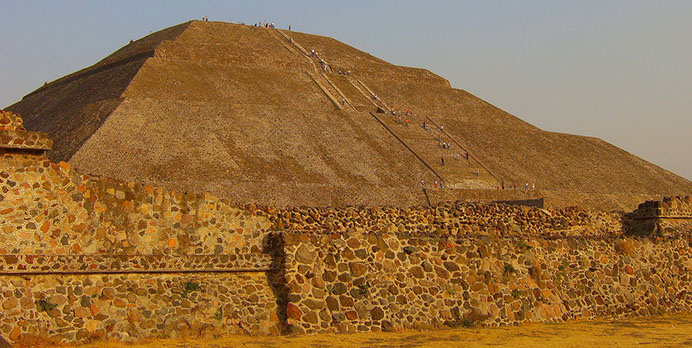
At 213 feet (64.92 m) high, The Pyramid of the Sun is the largest structure at Teotihuacán.
It has a staircase and a courtyard on the western side. The Aztecs built an altar in this courtyard, were they had ceremonies to honor their gods.
Archaeologists have found a large tunnel-like cave under the pyramid. Evidence suggests this was a religious site before the building of the pyramid. It could be the reason the builders constructed the pyramid on this particular site.
Temple of Quetzalcoatl
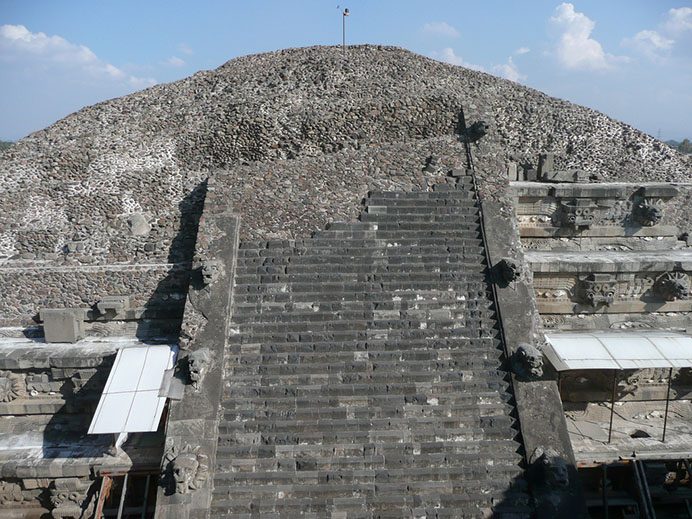
The Temple of Quetzalcoatl, or the Feathered Serpent Aggregate, is a six-position step aggregate. It’s located at the southern end of the Avenue of the Dead.
This structure has sculptural designs covering its surface. Many of these images represent Quetzalcoatl, the Feathered Serpent. Archeological evidence shows that the artists painted these designs using bright colors.
The Aztecs adopted Quetzalcoatl into their group of gods.
Worshippers entered the temple through a stone archway, which was carved to resemble a snake’s mouth.
Years later, the Spaniards, who regarded the snakes as evil because they associated serpents with stories about the Garden of Eden, destroyed as many snake images as they could.
The Great Pyramid at Cholula
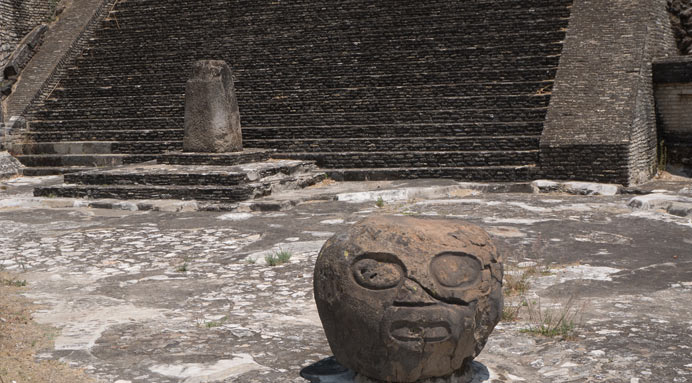
Cholula was a city that the Aztecs conquered. The Great Pyramid already stood when the Aztecs arrived. It is an Aztec temple because the Aztecs continued to use it for their own religious ceremonies. They believed Cholula was a home of Quetzalcoatl. It was a pilgrimage site for the Aztecs.
Some books about the Aztecs do not include information about the pyramid at Cholula. Scholars have not done extensive studies of this pyramid. They have dug a series of tunnels inside the pyramid, some of which are open to the public.
However, the outside cannot be fully excavated because a colonial church stands on its summit.
This pyramid is the largest ever built on earth. Each side is more than 1300 feet (396m) long, and it is over 180 feet (55m) high. Although the Great Pyramid at Giza is taller, it is not larger. The style of the Cholula pyramid is like those at Teotihuacán.

Tenochtitlán
Tenochtitlán, today known as Mexico City, was the capital of the Aztec empire. Despite its foundation on marshland, its inhabitants led an extremely efficient life; they used bridges, aqueducts, causeways and an elaborate agricultural system to produce enough food and produce to sustain the city’s huge population.
The Aztecs expanded the original area of Tenochtitlán, which consisted of a group of small islets on the western side of Lake Texcoco. The Templo Mayor, located in the heart of the great city, was its main place of worship.
Tlatelolco, a suburb of Tenochtitlán on the northern side of the lake, was an important commercial site in the area. It also had a temple at its core.
Templo Mayor (The Great Temple)

The Aztecs worshiped the same gods at the Templo Mayor as they did at the Tlatelolco temple. This Aztec temple had two flights of steep steps; the builders designed the steps to ensure that a body flung down them would fall straight to the bottom.
Archaeological excavations revealed seven distinct stages within the Templo Mayor.
Scholars found one of the early stages almost intact. This stage has two sanctuaries, which conforms to the description of the Templo Mayor from Spanish sources.
The excavators found the remains of offerings at the base of the temple. Archaeologists also found the remains of human sacrifices in the area surrounding the Templo Mayor.
Excavations revealed clues about the decoration of Aztec temples. Statues described as standard-bearers were on the steps of one temple stage. Excavation of the platform revealed statues of frogs and feathered serpents. Archaeologists found statues of other deities and a calendar stone (Xiuhpohualli) at the base of the temple.
The sanctuaries of the intact stage have two rooms, side by side. Each room had wooden beams surrounding the entrance. Carvings on the wall depict the god worshiped in the sanctuary. Inside each sanctuary was an idol of the deity. The colour of the paint on the walls reflected the attributes of the deity worshiped there.
Tlatelolco
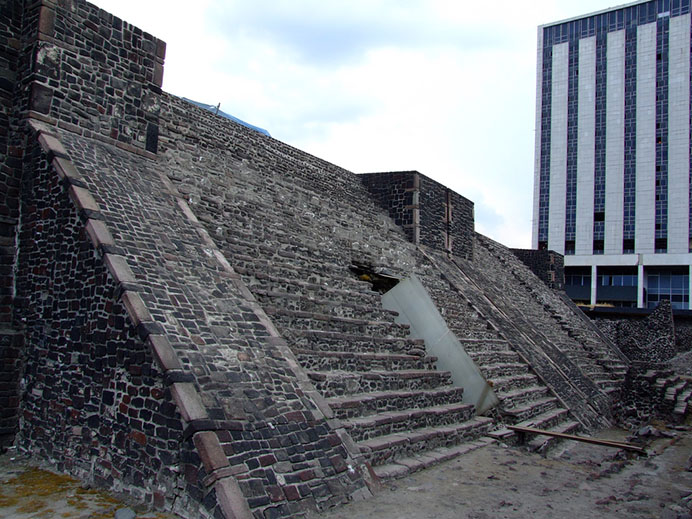
Scholars have excavated this city’s central temple. It is a step-pyramid with a double staircase topped by two sanctuaries.
The Aztecs worshiped Huitzilopochtli, their tribal god, in one sanctuary. They worshiped Tlaloc, a god honoured throughout Mesoamerica, in the second sanctuary.
Tlatelolco eventually merged with Tenochtitlán and together the two cities grew to become the largest and most prosperous metropolis of Mesoamerica.
Facts About Temples of the Aztecs
Aztec temples play an essential role in their daily life. Today, the temples at Teotihuacán, Cholula and Tenochtitlán are monuments to their builders. Numerous Aztec temples and other ruins are mapped in Google at this link.


